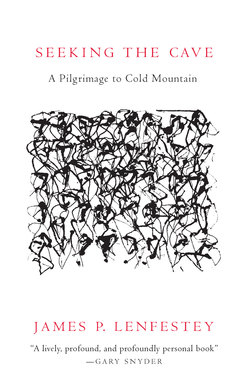Читать книгу Seeking the Cave - James P. Lenfestey - Страница 18
На сайте Литреса книга снята с продажи.
ОглавлениеCHAPTER FIVE
KYOTO KOAN
Kyoto’s train station is an architectural amazement—part open-air Roman amphitheater, part megamall, part public square, part edgy warehouse district, part mountain waterfall. I know of no building like it, a modern wonder in a city famously ancient, its dozens of temples spared by Allied bombers during World War II as the repository of Japanese Zen.
We caught a taxi to our hotel on Gojo Street in a modern section of town, then found lunch in a soba noodle shop in an old storefront. Over steaming bowls of fresh buckwheat noodles in ambrosial broth, I examined a guidebook to the temples of the region, some massive World Heritage sites, others small and out of the way. Where to begin? In my left-handed way I thumbed from the back of the book, where I learned that the smallest temple, Shisen-dō, was decorated with paintings of thirty-six ancient Chinese poets. The temple was originally built as a hermitage by samurai Ishikawa Jozan in 1641, to spend his retirement seclusion as a poet. The portraits honored his literary ancestors. That would be tomorrow’s beginning step.
The remainder of the afternoon we strolled gardens near the Imperial Palace and discovered Nishiki Shrine, where we happened upon a haiku festival. The entrance corridor of magenta bush clovers bloomed with white blossoms of paper haiku.
I tried my haiku hand.
At Nishiki Shrine,
clover flutters with haiku.
Mike looks. I listen.
The bronze bell tolls one,
then another, slowly six.
Morning? Or evening?
Mosquitos visit.
Crickets waken in the trees.
Sunset has arrived.
Ravens call, caw caw.
Multicolored finches sing.
Go on, laugh at me!
After dark, we stumbled hungrily through a low, hobbit-style door into a wacky, akimbo restaurant near the Imperial Palace. In a room as dim as a cave, we sat next to a Japanese couple fluent in English and who loved poetry. We drank saki and recited poems back and forth all night, from haiku to Han-shan, tears of delight rolling down our cheeks. Only when we paid our bill did I register the name of the restaurant: Ryōkan!
Early the next morning we bought daily bus passes, routes clearly described in pamphlets in a dozen languages, and were soon on our way to Shisen-dō, Mike rolling videotape along the way.
The bus kneeled to drop us off, Shisen-dō a short uphill walk from the quiet street. Through a rustic wooden gate, we entered a low wooden hall where we bought tickets and replaced our street shoes with sandals before entering the temple grounds. I examined the portraits of Chinese poets scowling down above the moon hall. I did not recognize Cold Mountain, but these poets had called us to heaven.
A hush rose and fell over the garden, down from overhanging maple and pine boughs, up from waves of raked white gravel and a gurgling rivulet muffled by a hedge. We sat on tatami mats on a platform open to this serene cosmos, mugs of whisked green tea appearing mysteriously at our elbows. A trickle from the stream fed the intermittent clack of a bamboo water clapper on the hillside. Designed to frighten deer from gardens, the clapper added the spice of sharp sound to the generous feast of murmuring brook, rustling maples, soughing pines, and whispering tourists unwinding their entire lives.
NAVIGATING THE INTELLIGENT BUS SYSTEM IN KYOTO
We step from the bus at the Zen garden of Shisen-dō,
where paintings of Chinese poets hover above the moon hall.
Lighter with our shoes off, we float raked gravel waves like paper boats.
All morning we sit with tea frothed from a woman’s deep sleeve.
Clack, clack, goes the water clapper, frightening no one.
Sigh, sigh, go the pine boughs listening overhead.
I do not know what practice put it right that we arrive here.
I do know the intelligent bus system will transport only our bodies home.
That afternoon we strolled Kyoto’s medieval cobbled lanes, busy with tourists, and the vast plaza of a massive Buddhist World Heritage site, where Mike shot volumes of tape. In a small side garden, people hung origami birds of haiku from the trees. In a park we watched a man kite his haiku skyward. But it is our quiet morning at Shisen-dō, stillness radiant with sound, that lingers with me still.
That night, our last in Kyoto, we sought out the same soba noodle shop where we’d begun, where fresh buckwheat dough hung like leather straps from wooden dowels before it was cut into strips on wooden blocks, then placed into broths that fed the body and more. Transported out of my mind by morning peace and evening ambrosia, I managed to forget my backpack under our table in the restaurant, my travel documents trapped inside. I woke with a start in the middle of the night, realizing what I had done. Early the next morning, train departure looming, I ran to the restaurant and pounded my palm on the dark window glass. What is the sound of one hand pounding? A puzzled prep cook emerged from the basement stairs. He wordlessly lifted my pack into the air with a knowing smile.
We made the train, the gods again on our side, with fifteen minutes to spare, only to board the wrong one. A kind conductor straightened us out, and we dropped at the next station to catch the right train eighteen minutes later. Although two days in Kyoto was a ludicrously short visit, I was relieved to return to the path toward Cold Mountain before I lost not only my head but my way as well!
